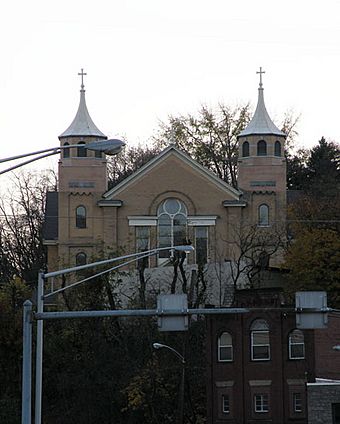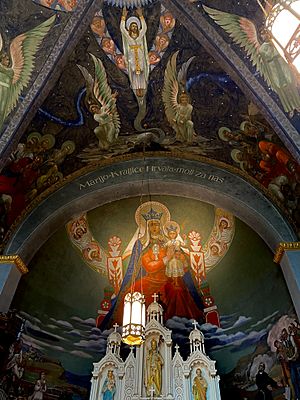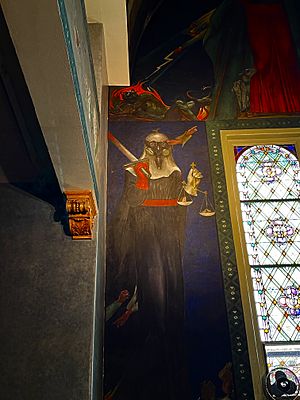St. Nicholas Croatian Church (Millvale, Pennsylvania) facts for kids
|
St. Nicholas Croatian Church
|
|
 |
|
| Location | 24 Maryland Ave., Millvale, Pennsylvania |
|---|---|
| Built | 1922 |
| Architect | Frederick C. Sauer (1860–1942) |
| NRHP reference No. | 80003404 |
Quick facts for kids Significant dates |
|
| Added to NRHP | May 6, 1980 |
St. Nicholas Croatian Church is a Roman Catholic church located in Millvale, Pennsylvania, USA. It is part of the Diocese of Pittsburgh. This church is special because it is listed on the National Register of Historic Places. It is also famous for its amazing murals painted by an artist named Maxo Vanka. He created these murals in 1937 and 1941. Some famous ones are Immigrant Mother Raises Her Sons for American Industry and The Capitalist. In 1937, Time magazine called the murals "one of the few distinguished sets of church murals in the U. S."
St. Nicholas is still an active parish church today. A parish church is a local church that serves a specific community. In 2019, it became a special "personal parish" within the Shrines of Pittsburgh. This means it's one of six churches the diocese wants to promote as places for people to visit and learn about.
Contents
History of the Church
The St. Nicholas Croatian Church was first started in 1900. This happened after a disagreement with another church nearby, also called St. Nicholas Croatian Church, in Troy Hill. The first stone for the new church was placed in July 1900. The church building was finished in November of the same year.
The building was designed in the Romanesque Revival style. This style uses elements from old Roman buildings. The architect was Frederick C. Sauer from Pittsburgh. The church cost about $34,000 to build. A famous businessman, Andrew Carnegie, even donated a pipe organ for the church in 1902.
Rebuilding After a Fire
In 1921, the church building burned down. People believed it was set on fire on purpose. Frederick C. Sauer, the original architect, was asked to design the new church. The new design was similar to the first one but a bit simpler. This current church building was officially opened on May 30, 1922.
After the church was rebuilt, the parish had a large debt. A priest named Albert Zagar had successfully helped another St. Nicholas church pay off its debt. So, in 1931, he was moved to St. Nicholas in Millvale. By 1937, he had paid off most of the debt. He then decided to use some money to decorate the church.
Maxo Vanka's Murals
Father Zagar wanted an artist who understood the Croatian culture of the church members. He asked a writer named Louis Adamic for help. Adamic suggested his friend, Maksimilijan "Maxo" Vanka. Vanka was a former professor at an art academy in Croatia. He had been looking for work since moving to the United States. He was very happy to get the job of painting murals for the church.
Vanka painted the first set of murals from April to June 1937. He worked very hard, sometimes until 2 or 3 in the morning. During this time, he thought the church was haunted by a ghostly figure. Louis Adamic later wrote about this in a magazine article. Even with this spooky experience, Vanka finished the murals on time.
The murals were very new and different because they showed scenes of workers inside a church. But people, including the press and church leaders, loved them. Because of this success, Vanka was asked to paint a second set of murals in 1941.
The later murals were officially shown on November 16, 1941. At this time, World War II was happening in Europe. So, these new murals showed strong anti-war messages. After all the murals were finished, the Pittsburgh Press newspaper said the artwork would make the church a "must see" place in Pittsburgh. Vanka himself said the murals were "my contribution to America."
The Famous Murals
There are 25 fresco murals by Maxo Vanka in the church. A fresco is a painting done on wet plaster. These murals cover the curved area behind the altar (called the apse), the walls, and the ceiling. They cover a huge area of about 4,500 square feet (418 square meters). Vanka painted the first group in 1937 and the rest in 1941.
The murals show a mix of traditional religious images and social themes. These themes are about the experiences of Croatian Americans, like war, unfairness, and the struggles of workers.
The apse and ceiling are decorated in the Byzantine style. Above the altar, there is an image of Mary, the Queen of Heaven. On the ceiling, you can see pictures of the Ascension of Jesus and the Four Evangelists.
In other parts of the church, Vanka painted scenes from the Old and New Testaments. He also painted images of saints. Many murals show the Croatian immigrant experience. For example, Immigrant Mother Raises Her Sons for American Industry shows Croatian women mourning a young man who died in a mining accident.
Other murals show ideas about unfairness and inequality in America. The American Capitalist shows a rich businessman eating a fancy meal while ignoring a poor person begging. Injustice shows a mysterious figure with a gas mask holding a scale. On the scale, a loaf of bread is lighter than gold, showing how unfair things can be. Vanka also included strong anti-war images. One shows a crucified Jesus being hurt by a World War I soldier's bayonet. Another shows the Virgin Mary breaking a soldier's rifle.
A different artist, Joko Knezevich, created an additional mural behind the altar in 1970.
The Society to Preserve the Millvale Murals of Maxo Vanka offers guided tours of the murals regularly. This helps people learn about and appreciate these amazing artworks. In 2022, a grant from the Save America’s Treasures program was given to help restore the murals. This grant was briefly stopped in April 2025 but was quickly restored a few weeks later. This happened thanks to the efforts of the Society and a local representative, Chris Deluzio.
See also





